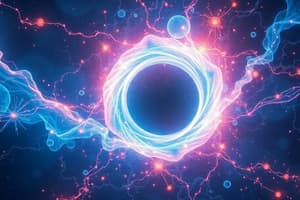Podcast
Questions and Answers
What is the atomic number of an atom defined by?
What is the atomic number of an atom defined by?
- The total number of subatomic particles it has
- The number of protons it has (correct)
- The number of protons and neutrons in its nucleus
- The number of electrons it has
What is the mass number of a given atom defined by?
What is the mass number of a given atom defined by?
- The number of protons and electrons in its nucleus
- The total number of subatomic particles it has
- The number of protons it has
- The number of protons and neutrons in its nucleus (correct)
Which subatomic particle has a negative charge and essentially 0 atomic mass units?
Which subatomic particle has a negative charge and essentially 0 atomic mass units?
- Electron (correct)
- Positron
- Neutron
- Proton
What is the charge of a proton and its atomic mass?
What is the charge of a proton and its atomic mass?
What is the charge of a proton?
What is the charge of a proton?
How is the mass number of an atom calculated?
How is the mass number of an atom calculated?
What does the atomic number of an element represent?
What does the atomic number of an element represent?
If an isotope of oxygen has 10 neutrons, how many protons does it have?
If an isotope of oxygen has 10 neutrons, how many protons does it have?
Who proposed the plum pudding model of the atom?
Who proposed the plum pudding model of the atom?
Which experiment led to the discovery of the atomic nucleus?
Which experiment led to the discovery of the atomic nucleus?
Who proposed the planetary model of the atom?
Who proposed the planetary model of the atom?
Which scientist's experiment allowed for the measurement of the charge of an electron?
Which scientist's experiment allowed for the measurement of the charge of an electron?
Whose model proposed that electrons exist within specific energy levels and exhibit wave-like behavior?
Whose model proposed that electrons exist within specific energy levels and exhibit wave-like behavior?
What is the atomic mass of an element based on?
What is the atomic mass of an element based on?
Which of the following accurately describes isotopes of the same element?
Which of the following accurately describes isotopes of the same element?
What did Rutherford's model of the atom introduce?
What did Rutherford's model of the atom introduce?
What is the purpose of atomic theory?
What is the purpose of atomic theory?
Who initially proposed the concept of atoms as the smallest identifiable pieces of matter?
Who initially proposed the concept of atoms as the smallest identifiable pieces of matter?
What causes variation in mass number among isotopes of the same element?
What causes variation in mass number among isotopes of the same element?
What distinguishes isobars from isotopes?
What distinguishes isobars from isotopes?
Study Notes
Atomic Theory and Its Development
- The atomic number defines elements, indicating the number of protons in an atom of a specific element.
- Mass number varies among isotopes of the same element due to differing numbers of neutrons in their nuclei.
- Isotopes of elements exist in known frequencies, aiding in the estimation of the mass number of a given atom.
- Isobars are atoms of different elements with the same total atomic mass, despite having different numbers of protons and neutrons.
- Atomic mass is the weighted average of mass numbers of all atoms of an element, calculated based on relative isotope frequencies.
- The debate in ancient Greece on the nature of matter led to the concept of atoms, initially proposed by Democritus.
- Atoms are the smallest identifiable pieces of matter and consist of protons, neutrons, and electrons.
- The purpose of atomic theory is to understand the nature and behavior of matter, facilitating technological advancements.
- John Dalton, in the 1800s, supported and expanded upon Democritus' atomic theory, providing the first model of the atom.
- Subsequent experiments by J.J. Thomson, Ernest Rutherford, Niels Bohr, and Robert Millikan further refined the understanding of atomic structure.
- Early models of the atom by Dalton and Thomson involved solid spheres, while Rutherford's model introduced the idea of a nucleus and distinct orbiting particles.
- The historical development of atomic theory has provided a deeper understanding of the atom's composition, structure, and behavior.
Studying That Suits You
Use AI to generate personalized quizzes and flashcards to suit your learning preferences.
Description
"Evolution of Atomic Models and Atomic Theory Development Quiz" - Test your knowledge of the historical progression of atomic models from Dalton's solid sphere to Schrodinger's quantum electron cloud model. Explore the development of atomic theory, including concepts such as atomic number, mass number, isotopes, and the contributions of key scientists to our understanding of atomic structure.




